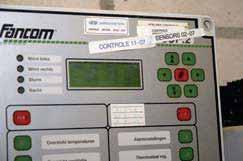
1 minute read
Assessing ventilation in the poultry house
Assessing ventilation in the poultry house
In floor housing systems, the distribution of birds over the house tells you something about the quality of ventilation. But you can also assess the ventilation in other ways. Enter the house with bare, wet arms or wearing shorts, go and stand in the parts of the house where there are too few chicks and feel whether there is a draught there. Check whether the litter feels cold. See whether there is a pattern in the way the birds are distributed throughout the house and whether this has anything to do with the position of the lamps, fans, air inlet etc. If you change the settings, give the chicks a couple of hours to adjust. Don’t conclude too quickly that the change has not worked or is no good. Make a note of what you have changed.
Advertisement
Poor ventilation with floor rearing
If you cannot feel it yourself, do a smoke test to see how quickly the air is flowing through the house. You don’t have to take the chicks out of the house to do this. There are several options: The fresh, cold air in the middle sinks and there is little air movement at the sides. The chicks avoid the middle and go to the sides of the house, resulting in damp litter. Reduce the underpressure.
Good ventilation
The fresh, cold air sinks too quickly and is therefore not being heated up enough. The chicks keep to the outermost quarters and the middle of the house. This has created two empty strips down the length of the house: a zebra crossing effect. Increase the underpressure.copyright protected Avoid ventilation errors. Check all your equipment at set times.
The chicks move away from the edges and are mainly in the middle. The flaps are too tightly shut so there is too little air entering through each flap which dissipates too quickly. Open some of the flaps about two fingers more. In hot weather the flaps will turn. The air will pass right over the chicks at high velocity. This will make the air feel quite cool near the birds (wind chill effect). This should only be done deliberately if the ambient temperature is very high. Source: Henk Rodenboog










